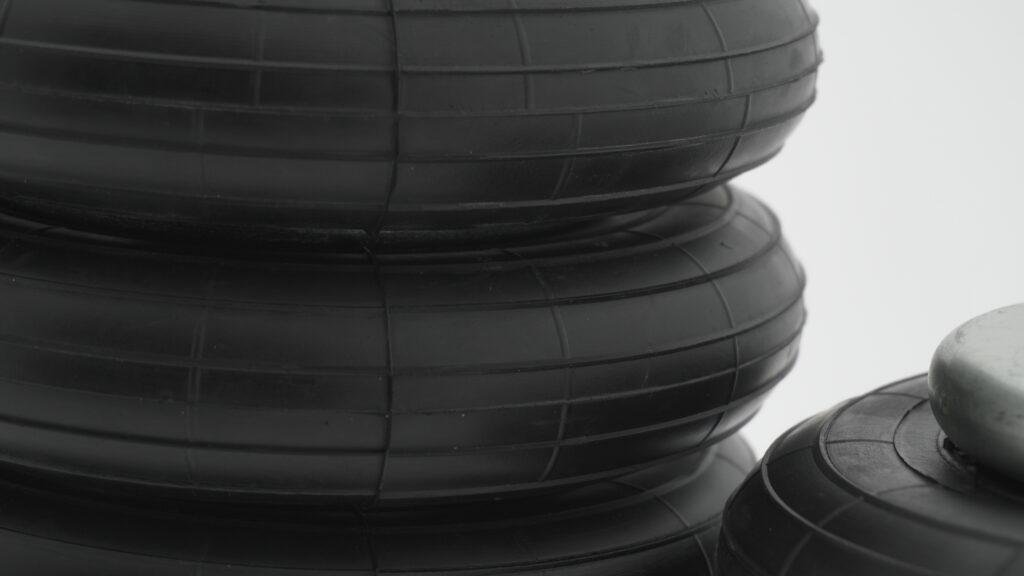
Although air bellows are primarily recognized for their industrial use, they also play a growing role in automotive systems. This article outlines the applications of air bellows in the automotive industry, exploring both traditional and emerging use cases. From vehicle suspension to production line automation, air bellows contribute to comfort, efficiency, and performance. Their unique ability to isolate vibration, compensate for load variations, and provide precise actuation makes them valuable across the vehicle lifecycle. We explore their role not only within vehicles but also in the manufacturing processes that build them. Understanding these applications helps designers and engineers identify opportunities to integrate air bellows into automotive solutions.
Vehicle Suspension Systems for Ride Comfort
One of the most common applications of air bellows in the automotive industry is within air suspension systems. Used in commercial trucks, buses, and high-end passenger vehicles, air bellows replace steel coil springs to provide adjustable ride height and improved comfort. The flexible rubber construction and internal pressure control allow the suspension to adapt to different loads and road conditions. Air bellows in suspension isolate road vibrations, reducing fatigue for both drivers and passengers. They also improve vehicle handling by maintaining consistent chassis height. The result is smoother driving, lower tire wear, and enhanced control. As comfort and customization become more important, air suspension continues to grow across vehicle segments.
Axle and Cab Suspension in Heavy Vehicles
In trucks and buses, air bellows are essential for axle suspension and cab mounting systems. They absorb shocks from rough terrain, protecting mechanical components and reducing cabin vibration. This not only improves comfort but also extends the life of sensitive instruments and electronics within the vehicle. Cab-mounted air bellows support driver health by minimizing exposure to continuous low-frequency vibration. These systems often use double- or triple-convolution designs for greater stroke and flexibility. For long-haul operations, the reduced stress improves safety and reduces driver fatigue. With rising demand for ergonomic vehicle design, air bellows have become a standard component in commercial vehicle suspension.
Height Control for Load Compensation
Another important function of air bellows in the automotive industry is height control in load-sensitive applications. As vehicle load increases, air pressure within the bellows is automatically adjusted to maintain consistent ride height. This prevents the vehicle body from sagging or tilting, which improves braking stability, steering response, and overall safety. Load leveling is especially important in ambulances, delivery vans, and trailers where cargo weight varies. By maintaining chassis alignment, air bellows reduce wear on driveline components and improve fuel efficiency. Their compact design also simplifies integration into multi-axle and trailer suspension systems, making them a flexible solution for modern transport needs.
Noise and Vibration Isolation in EV Platforms
Electric vehicles introduce new challenges in managing noise and vibration. With combustion engines eliminated, secondary vibrations become more noticeable to occupants. Air bellows are increasingly used to isolate these vibrations from battery trays, inverters, and drive units. Their soft spring rate and tunable pressure allow engineers to target specific frequencies for isolation. In EV platforms, air bellows contribute to a quieter cabin and improved component life. They also absorb shocks during charging or loading, protecting delicate electronics. As EV design evolves, vibration control becomes a priority, and air bellows offer a proven solution. Their durability and adaptability support the demands of lightweight and noise-sensitive architectures.
Seating and Interior Adjustment Systems
Beyond suspension, air bellows are integrated into seat adjustment mechanisms and interior support systems. They allow smooth, quiet, and adjustable movements without mechanical friction. In luxury vehicles, air-actuated lumbar supports and seat height adjusters use miniaturized bellows for silent comfort. These bellows offer ergonomic motion with minimal power requirements. They also eliminate the need for complex gear systems or electric motors. In some cases, air bellows are also used in convertible roof systems, where controlled inflation moves soft-top components into position. Their compactness, responsiveness, and long service life make them ideal for space-constrained, repetitive-motion applications inside the cabin.
Air Bellows in Automotive Production Equipment
Apart from vehicle use, many applications of air bellows in the automotive industry occur on the production line. Assembly stations, stamping presses, conveyors, and robotic platforms use air bellows for vibration isolation and stroke control. They provide cushioning for parts during assembly and position adjustment during component placement. In welding and paint booths, they absorb motion and prevent transfer of vibration to critical structures. Their maintenance-free design and compact profile reduce system downtime and improve throughput. Automotive factories benefit from their ability to work in harsh, repetitive, and precise environments. Air bellows enable consistent product quality through process stabilization.
Aftermarket Retrofits and Custom Conversions
Air bellows are also popular in the automotive aftermarket, particularly for suspension conversion kits. Enthusiasts install them for lowered ride heights or adjustable stance in show vehicles. Commercial fleet operators use retrofitted air suspension for improved comfort or cargo handling. Retrofit kits typically include air bellows, compressors, tanks, and control modules. Because air bellows allow dynamic adjustment, they appeal to applications where appearance or function needs to change frequently. This flexibility contributes to growing demand in recreational, fleet, and performance sectors. Reliable performance and easy integration make air bellows an attractive upgrade option.
